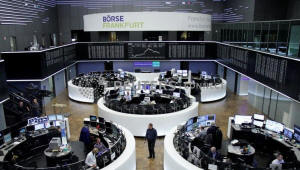|
Bond yields on the canvas, Turkey's lira
on the ropes
 Send a link to a friend
Send a link to a friend
 [March 28, 2019]
By Marc Jones [March 28, 2019]
By Marc Jones
LONDON (Reuters) - Global bond yields
continued to spiral lower on Thursday as recession fears fed
expectations of more policy easing by major central banks, while
Turkey's lira took a 5 percent beating as pressure ratcheted up on its
volatile markets again.
Europe and Asia's top share markets did manage to steady, but with the
end of what has been rollercoaster first quarter of the year for traders
there was plenty to try and keep track of.
Sterling was hit by a bout of Brexit blues after a round of votes in the
U.K. parliament failed to produce any clarity or new plan to manage its
divorce from the European Union.
A Reuters report that the United States and China had made progress in
all areas in trade talks seemed to bolster sentiment a little, though
sticking points still remained and there was no definite timetable for a
deal.
Early European moves saw London's FTSE climb 0.75 percent and Frankfurt
and Paris both add 0.4, after a 1.6 percent tumble in Tokyo overnight
had been offset by much of the rest of Asia-Pacific nudging higher.

Credit rating firm S&P Global became the latest to chop its euro zone
growth forecasts while E-Mini futures for the S&P 500 seemed uncertain
which way New York would go later.
Worries that the inversion of the U.S. Treasury curve signaled a future
recession only deepened as 10-year yields fell to a fresh 15-month low
at 2.34 percent.
"We think that the ongoing flattening, or outright inversion, of the
curve is a bad sign for equities, as it usually has been in the past,"
said Oliver Jones, markets economist at Capital Economics.
"Arguments that the yield curve is no longer a reliable indicator seem
to resurface every time it inverts, only to be subsequently proved
wrong."
The latest lunge lower in German bunds yields appeared to have eased at
least, having dived deeper into negative territory on Wednesday after
European Central Bank President Mario Draghi said a hike in interest
rates could be further delayed.
Plans to mitigate the side-effects of negative interest rates could also
be considered, suggesting the central bank was preparing for an extended
period below zero.
That shift came hot on the heels of a dovish surprise on Wednesday from
the Reserve Bank of New Zealand, which abandoned its neutral bias to say
the next rate move would likely be down.

Yields in both New Zealand and neighbor Australia, sank to record lows
in response.
[to top of second column]
|

The German share price index, DAX board, is seen at the stock
exchange in Frankfurt, Germany, November 24, 2017.
REUTERS/Staff/Remote

LIRA FREEFALL
Turkey's lira, one of the currencies at the heart of last year's
emerging market meltdown, plunged as much as 5 percent against the
dollar amid worries that the economic and geopolitical risks are on the
rise again there.
Authorities were showing the first sign of easing a draconian squeeze
put on international lira traders ahead of local elections this weekend
but a day after the country's stock market also slumped there was little
good will.
Ugras Ulku at the International Institute of Finance in Washington said
the question was, when the dust settles, whether portfolio managers want
to continue to invest in Turkey or not "we will have to wait and see,"
he said
Elsewhere, hints of rate cuts from New Zealand's central bank had the
desired effect on its currency, which was pinned at $0.6816 after diving
1.6 percent overnight. The Aussie was on the defensive at $0.7090.
Draghi's comments likewise kept the euro back at $1.1250, and left the
U.S. dollar a fraction firmer against a basket of its competitors at
96.874.
Only the yen held its own thanks to its safe-haven status and firmed to
110.00 per dollar.
Sterling had its own troubles as an offer by British Prime Minister
Theresa May to quit to get her European Union deal through parliament
failed, leaving uncertainty hanging over the Brexit process.
That left the pound down at $1.3150, though that was up from an
overnight trough of $1.3140.

In commodity markets, palladium was the focus of attention after sliding
7 percent on Wednesday as its meteoric rally finally ran into
profit-taking. It was down 0.4 percent on Thursday.
Gold was relatively sedate at $1,310.85 per ounce.
Oil prices nursed modest losses after data showed U.S. crude inventories
grew more than expected last week as a Texas chemical spill hampered
exports.
U.S. crude was last down 18 cents at $59.23 a barrel, while Brent crude
futures lost 10 cents to $67.73.
(Additional reporting by Wayne Cole in Sydney; Editing by Raissa
Kasolowsky)
[© 2019 Thomson Reuters. All rights
reserved.]
Copyright 2019 Reuters. All rights reserved. This material may not be published,
broadcast, rewritten or redistributed.
Thompson Reuters is solely responsible for this content. |